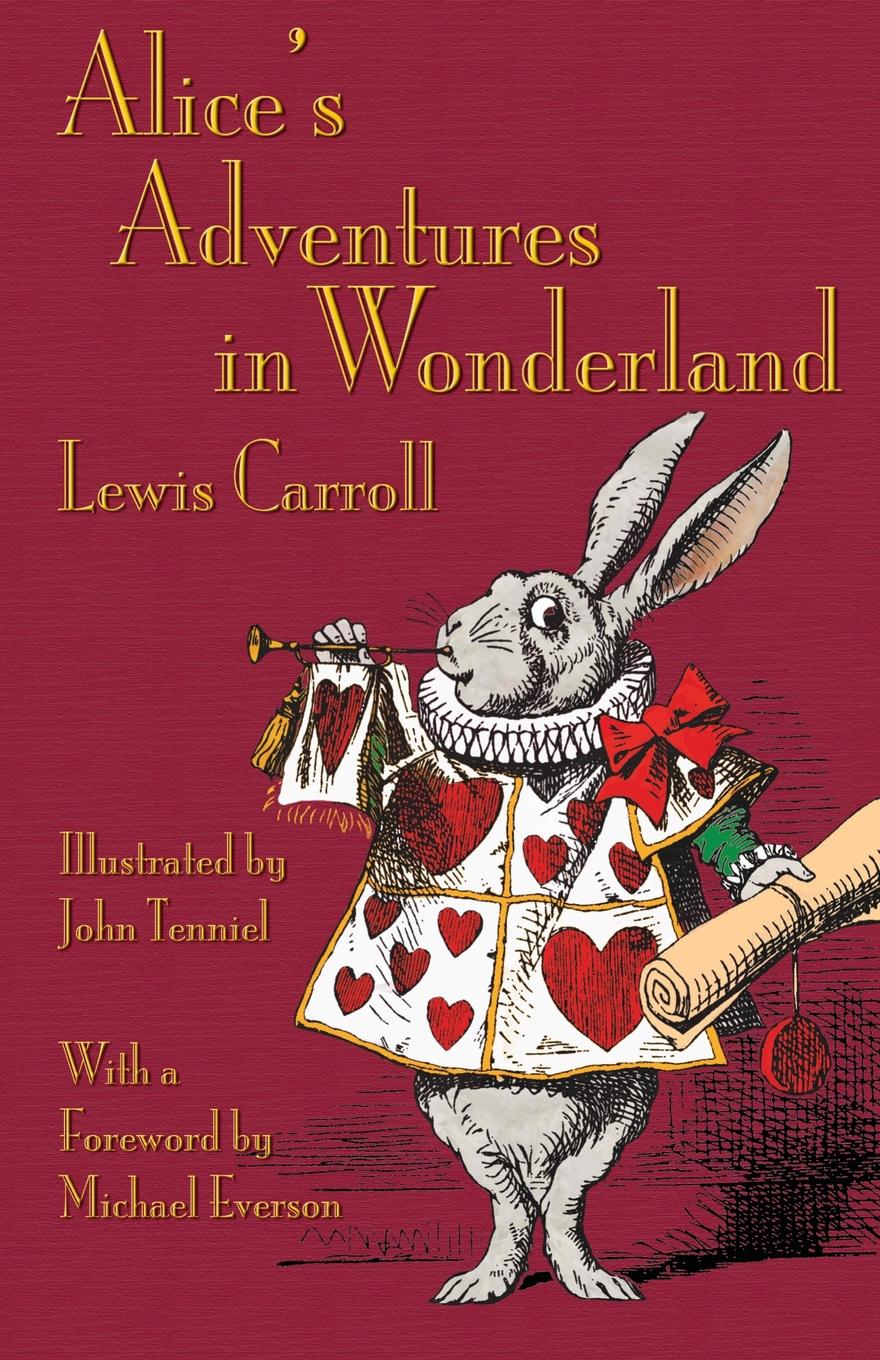Alice's Adventures in Wonderland

By Lewis Carroll
Second edition, 2015. Illustrations by John Tenniel. Portlaoise: Evertype. ISBN 978-1-78201-125-5 (paperback), price: €11.95, £8.95, $14.95.Click on the book cover on the right to order this book from Amazon.co.uk!
Or if you are in North America, order the book from Amazon.com!
| “In that direction,” the Cat said, waving its right paw around, “lives a Hatter: and in that direction,” waving the other paw, “lives a March Hare. Visit either you like: they’re both mad.” | ||
| “But I don’t want to go among mad people,” Alice remarked. | ||
| “Oh, you ca’n’t help that,” said the Cat: “we’re all mad here. I’m mad. You’re mad.” | ||
| “How do you know I’m mad?” said Alice. | ||
| “You must be,” said the Cat, “or you wouldn't have come here.” | ||

|
||
|
Lewis Carroll is a pen-name: Charles Lutwidge Dodgson was the author’s real name and he was lecturer in Mathematics in Christ Church, Oxford. Dodgson began the story on 4 July 1862, when he took a journey in a rowing boat on the river Thames in Oxford together with the Reverend Robinson Duckworth, with Alice Liddell (ten years of age) the daughter of the Dean of Christ Church, and with her two sisters, Lorina (thirteen years of age), and Edith (eight years of age). As is clear from the poem at the beginning of the book, the three girls asked Dodgson for a story and reluctantly at first he began to tell the first version of the story to them. There are many half-hidden references made to the five of them throughout the text of the book itself, which was published finally in 1865.
In 2003 when I published Eachtraí Eilíse i dTír na nIontas, Nicholas Williams’ splendid Irish translation of Alice’s Adventures in Wonderland, I had no idea how large a part Alice and her world would come to play in my life and work. As of this writing, I have published this book in over 50 languages, together with Through the Looking-Glass, The Hunting of the Snark, and many volumes of sequels, parodies, and works inspired by Alice. The text for this edition is based on that established in Selwyn Goodacre’s version of Lewis Carroll’s final revised text of 1897; Goodacre’s edition is augmented “with certain corrections, and elimination of errors”. To that text I have made a number of further alterations in order to correct some inconsistencies which remained, or which appear to have been introduced, in Carroll’s final revised text. The first of these changes is in the area of spelling. Apart from Carroll’s characteristic ca’n’t, sha’n’t, and wo’n’t, Oxford spelling has been used here. So toffee is preferred to the less-used variant toffy (p. 13), anyone to any one (p. 18), scurried to skurried (p. 18), salt water to salt-water (pp. 20, 28), fairy tales to fairy-tales (p. 35), recognized to recognised (p. 79), croquet balls to croquet-balls (p. 82), and undertone to under-tone (pp. 115, 118). Although labelled, quarrelled, and quarrelling appear in the “People’s Edition” (first published in 1887), Carroll seems to have changed these to labeled, quarreled, and quarreling in his 1897 revised text. It is possible that he had a notion that labeled should be pronounced as [ˈleɪbǝld] and labelled as [ləˈbɛld]—but even if a sensible reform it hasn’t been taken up, so the Oxford spelling has been used (pp. 9, 71, 83, 92). Carroll’s use of colons and semicolons is much more frequent and much less predictable than the use that we make of these characters today, and there is no convenient way of rationalizing these, they have been left as he had them. But in the matter of quotation marks and em dashes a certain inconsistency can be easily avoided. In the “People’s Edition” he writes “…‘How doth the little—’” but in the 1897 edition he writes “…‘How doth the little—’,” with logical placement of the comma outside the single quotation mark but inside the double. Similarly he writes “Did you say ‘pig’, or ‘fig’?” said the Cat. in the 1897 edition; the “People’s Edition” had no single quotation marks at all. For consistency, logical quotation marks have been used throughout thus: MARMALADE,” has been changed to MARMALADE”, (p. 9); Drink Me,” to Drink Me”, (p. 13); poison,” to poison”, (twice, p. 13); DRINK ME,” to DRINK ME”, (p. 34); “arrum.”) to “arrum”.) (p. 37); bee,’ to bee’, (p. 45); William,’” to William’,” (p. 45); themselves,’” to themselves’,” (p. 90); together.’” to together’.” (p. 90); yours.’” to yours’.” (p. 90); otherwise.’” to otherwise’.” (p. 91); moral,” to moral”, (p. 91); Uglification,’” to Uglification’,” (p. 95); sluggard,’” to sluggard’,” (p. 103); Soup,’ to Soup’, (p. 106); creatures,” to creatures”, (p. 109); stupid,” to stupid”, (p. 109); court,’ to court’, (p. 113); “important,” and some “unimportant.” to “important”, and some “unimportant”. (p. 118); and him to you,’” to him to you’,” (p. 122). The placement of a comma inside a closing parenthesis occurred in a number of places. Sometimes the open parenthesis was preceded by a comma. These have been regularized: circle, (“the exact shape doesn’t matter,” it said,) has been changed to circle (“the exact shape doesn’t matter,” it said), (p. 27); some were birds,) to some were birds), (p. 109); and Alice, (she had grown … interrupting him,) to Alice (she had grown … interrupting him), (p. 121); For March Hare,) the change has been to March Hare) (p. 71); the comma was simply deleted, because the parenthetical remark was set off by em dashes. In general Carroll uses em dashes to break off speech, and when he does so, the em dashes are kept within the quotation marks. In one instance under the sea—” (“I haven’t,” said Alice)—“and perhaps was changed to under the sea—” (“I haven’t,” said Alice) “—and perhaps (p. 98). A relatively large change made by Carroll was to add a redundant comma or full stop after phrases that ended in ?” or !”. This unusual practice was not found in the “People’s Edition” and there is really nothing to recommend it. So cats?”, has been changed to cats?” (p. 10); bat?”, to bat?” (p. 10); way?”, to way?” (p. 14); chatte?”, to chatte?” (p. 22); away!”, to away!” (p. 27); over!”, to over!” (p. 28); coward!”, to coward!” (p. 38); again!”, to again!” (p. 40); “What?”. to “What?” (p. 42); nose!”, to nose!” (p. 59); Queen!”, to Queen!” (p. 78); this?”. to this?” (p. 79); about it!”, to about it!” (p. 94); too far!”, to too far!” (p. 101); court!”, to court!” (p. 109); and “Silence!”, to “Silence!” (p. 118). Goodacre capitalizes a number of words following exclamation marks, but Carroll does not do this and non-capitalization is standard for the mid-nineteenth century, so Goodacre’s thump! Thump! Down has been changed to the original thump! thump! down (p. 10), alas! Either to alas! either (p. 11), alas for poor Alice! When to alas for poor Alice! when (p. 14), alas! The to alas! the (p. 20), splash! She to splash! she (p. 20), Wow! Wow! Wow! to Wow! wow! wow! (p. 60). Some miscellaneous changes: the Goodacre text writes hammer’d (because Carroll also writes wither’d and pluck’d in that poem) but the standard spelling hammered has been retained as Carroll has it (p. 6). A paragraph break has been added before “Hold your tongue, Ma!” (p. 31). A reversal has been made changing “This is Bill”, to “This is Bill,” (p. 38). An odd bit of punctuation has been simplified for consistency, changing flappers,—“Mystery to flappers. “Mystery (p. 96). Finally there is the matter of em dashes. For whatever reason, sometimes Carroll uses a single em dash — and sometimes a double em dash ——. I can glean no semantic function here; perhaps it is to avoid too much white space here or there, but often the double marks occur at the end of a line which is nowhere bear the margin. In any case, since there’s no discernible reason for distinguishing these as anything but a typographic anomaly, so I have simplified all but one of the double em dashes to single ones (p. 105). With that, in this sesquicentenary since Alice was first published, I establish a definitive text for Evertype publications. I have aimed to introduce (or re-introduce) clarity and consistency where it was lacking, while conserving the idiosyncracies of Carroll’s writing which have delighted readers for a century and a half. Michael Everson |
||